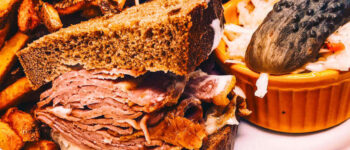Spicy food is a delicacy that is enjoyed by many people around the world. However, not everyone is capable of tolerating spicy foods. While some can eat hot chili peppers with ease, others may struggle with mild salsa. If you’re one of the latter, don’t worry. With a little patience and practice, you can learn how to build your spice tolerance and even enjoy the full range of flavors that hot sauces have to offer. In this blog post, we’ll explore the science behind spiciness and give you some tips on how to build your tolerance for spicy foods.
The Science Behind Spiciness
The sensation of spiciness is caused by the presence of a compound called capsaicin. Capsaicin is found in chili peppers, and it’s what makes them spicy. When you eat a chili pepper or consume a hot sauce that contains capsaicin, it binds to receptors on your tongue and mouth called TRPV1 receptors. These receptors are responsible for detecting temperature and pain.
When capsaicin binds to TRPV1 receptors, it triggers a response from your body that is similar to the way it responds to heat. Your body thinks that your mouth is being burned, and it reacts accordingly. Your heart rate may increase, your body may sweat, and you may experience a release of endorphins, which are natural painkillers. This reaction is what causes the sensation of spiciness.
Why Some People Love Spicy Foods
Some people enjoy the sensation of spiciness because of the rush of endorphins that it produces. Endorphins are natural painkillers that are released by your body in response to pain, stress, or fear. When you eat spicy foods, your body thinks that your mouth is in pain, so it releases endorphins to help relieve the discomfort. The release of endorphins can create a feeling of euphoria or pleasure, which is why some people enjoy eating spicy foods.
Tips for Building Your Tolerance for Spicy Foods
Start with Mild Hot Sauces
When it comes to building your spice tolerance, it’s important to start slow and gradually increase the heat. Your taste buds need time to adjust to the sensation of heat, and if you push yourself too hard too soon, you could end up ruining your meal or hurting your stomach. Start by incorporating milder spices, such as black pepper or paprika, into your meals. Once you’re comfortable with those, move on to slightly spicier spices, such as cayenne pepper or red pepper flakes. Over time, you can gradually increase the heat level of your meals by adding hotter peppers or spices. Try our mildest hot sauce variety pack!
Practice Makes Perfect
Eat spicy foods regularly to help build your tolerance. Start with small amounts of heat and gradually increase the amount and intensity over time. This will help your body get used to the sensation of spiciness and reduce the discomfort you may feel. Building your tolerance for spicy foods takes time, and it won’t happen overnight. Be patient and persistent, and don’t give up if you experience discomfort or burnout. Your taste buds will gradually adapt to the heat, and you’ll be able to handle spicier foods in no time.
Don’t Fight Fire with Fire
Trying to cool down your mouth with water, beer or soda will only spread the capsaicin, making the burn worse. Water is a good option for milder spices or peppers, but if you’re dealing with a particularly spicy dish, you may want to opt for milk instead. Milk is especially effective because it contains casein, a protein that binds to the capsaicin molecules (the compounds that give peppers their heat) and helps to wash them away. Capsaicin is fat-soluble, so dairy products can help to neutralize its effects.
Pair Spicy Foods with Cooling Foods
See more : How Much Meat Per Person for BBQ - Planning Guide
Spicy foods can be intense and overwhelming, but you can balance the heat by pairing them with cooling foods. This will help to soothe your mouth and reduce the burning sensation. Some good options for cooling foods include yogurt, sour cream, avocado, or coconut milk. You can also try pairing spicy foods with fruits or vegetables that have a high water content, such as watermelon, cucumber, or celery.
Experiment with Different Cuisines
Some cultures use spices more frequently than others. By trying dishes from different cultures, you can expose your taste buds to different levels of heat, and even discover new types of heat that you may prefer. This will help you to build your tolerance for spicy foods and expand your palate. If you’re not sure where to start with spicy foods, try incorporating spicy sauces or condiments into your meals. This will allow you to control the level of spiciness and gradually build up your tolerance. There are many different spicy sauces and condiments to choose from, such as hot sauce, sriracha, salsa, or chili paste. You can add them to your eggs, sandwiches, burgers, or stir-fries, or use them as a marinade for meat or vegetables.
Know Your Limits
While it’s important to challenge yourself and push your limits when building your tolerance for spicy foods, it’s also important not to push yourself too hard. If you go too far too quickly, you could end up ruining your meal or hurting your stomach.
Try Capsaicin Supplements
Capsaicin is the compound that gives peppers their heat, and it’s also available in supplement form. Capsaicin supplements can help to build your tolerance for spicy foods by gradually exposing your taste buds to the heat.However, it’s important to speak with your healthcare provider before taking any new supplements, especially if you have any underlying health conditions or are taking any medications.
Build a Support System
Building your tolerance for spicy foods can be a fun and rewarding experience, but it can also be challenging at times. That’s why it’s important to build a support system to help you through the process. Find friends or family members who enjoy spicy foods and who can offer encouragement and support. You can also join online communities or forums where people share tips and advice on building their tolerance for spicy foods.
Don’t Be Afraid to Experiment
Finally, don’t be afraid to experiment and try new things when building your tolerance for spicy foods. There are so many different types of spices, peppers, and cuisines to explore, and each one offers a unique and exciting flavor experience.Try new recipes, visit new restaurants, and experiment with different types of peppers and spices. Who knows - you might just discover a new favorite dish or flavor!
How to cool down your mouth when eating spicy foods
Drink Milk or Eat Dairy Products
Milk and dairy products like yogurt and cheese can help neutralize the capsaicin in spicy foods. Capsaicin is the compound responsible for the burning sensation in your mouth, and dairy products contain a protein called casein that can bind to the capsaicin and help remove it from your mouth.
Eat Cooling Foods
Eating cooling foods like cucumber, watermelon, and pineapple can help soothe your mouth after eating spicy foods. These foods contain high amounts of water and can help hydrate your mouth and cool down the burning sensation.
Use Citrus Fruits
See more : Sardines: what you need to know about fish in a tin
Citrus fruits like lemons, limes, and oranges contain high amounts of citric acid, which can help cut through the spiciness and provide relief. Squeeze some lemon or lime juice on your food or drink a glass of orange juice to help cool down your mouth.
Drink Water
Drinking water can help wash away the capsaicin from your mouth and provide temporary relief from the burning sensation. However, be aware that water can actually spread the capsaicin around your mouth, so it’s important to pair it with other cooling foods or drinks.
Benefits of building your tolerance for spicy foods
Increased Enjoyment of Food
Spicy foods can add a unique and exciting flavor to dishes that might otherwise be bland. By building your tolerance for spicy foods, you can enjoy a wider variety of cuisines and dishes that incorporate spicy ingredients.
Health Benefits
Spicy foods have been shown to have several health benefits, including boosting metabolism, reducing inflammation, and promoting heart health. By incorporating more spicy foods into your diet, you may be able to reap these health benefits.
Cultural Appreciation
Many cultures around the world incorporate spicy ingredients into their traditional dishes. By building your tolerance for spicy foods, you can gain a deeper appreciation and understanding of these cultures and their cuisines.
Social Benefits
Enjoying spicy foods with friends and family can be a fun and social activity. By building your tolerance for spicy foods, you can join in on the fun and enjoy the shared experience of trying new and exciting dishes.
Culinary Skills
If you enjoy cooking, building your tolerance for spicy foods can help you develop your culinary skills. You can experiment with different types of peppers and spices to create unique and flavorful dishes.
Conclusion
In conclusion, building your tolerance for spicy foods is a process that requires patience, persistence, and a willingness to experiment. By starting slow, pairing spicy foods with cooling foods, drinking plenty of water or milk, and being patient and persistent, you can gradually increase your tolerance for heat and enjoy a wider variety of spicy foods. It’s also important not to push yourself too hard, to build a support system, and to experiment with new flavors and cuisines. And if you find yourself struggling with the heat, there are several ways to cool down your mouth, such as drinking milk, eating cooling foods, using citrus fruits, drinking water, or trying bread or starchy foods. Ultimately, building your tolerance for spicy foods can offer several benefits, including increased enjoyment of food, health benefits, cultural appreciation, social benefits, and culinary skills. So why not give it a try and see where your love for spicy food takes you?
Nigel Gildon editor:Nigel Gildon is the editor of Chef Wayne’s Big Mamou: Chef Wayne’s Big Mamou. He has worked in the publishing industry for many years and has a passion for helping new authors get their work into the hands of readers. 63 Liberty Street * Springfield, MA 01003




